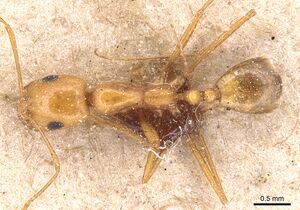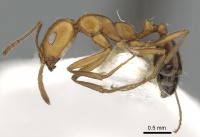Monomorium luteum
| Monomorium luteum | |
|---|---|

| |
| Scientific classification | |
| Kingdom: | Animalia |
| Phylum: | Arthropoda |
| Class: | Insecta |
| Order: | Hymenoptera |
| Family: | Formicidae |
| Subfamily: | Myrmicinae |
| Tribe: | Solenopsidini |
| Genus: | Monomorium |
| Species group: | salomonis |
| Species: | M. luteum |
| Binomial name | |
| Monomorium luteum Emery, 1881 | |
Collection records show this species has been found foraging and in ground nests, in habitats that range from agricultural areas (irrigated date and olive trees), roadside desert, and rocky washes with vegetation.
Identification
Distribution
Latitudinal Distribution Pattern
Latitudinal Range: 15.116667° to 12.717377°.
| North Temperate |
North Subtropical |
Tropical | South Subtropical |
South Temperate |
- Source: AntMaps
Distribution based on Regional Taxon Lists
Afrotropical Region: Saudi Arabia, United Arab Emirates, Yemen (type locality).
Palaearctic Region: Oman.
Distribution based on AntMaps
Distribution based on AntWeb specimens
Check data from AntWeb
Countries Occupied
| Number of countries occupied by this species based on AntWiki Regional Taxon Lists. In general, fewer countries occupied indicates a narrower range, while more countries indicates a more widespread species. |

|
Estimated Abundance
| Relative abundance based on number of AntMaps records per species (this species within the purple bar). Fewer records (to the left) indicates a less abundant/encountered species while more records (to the right) indicates more abundant/encountered species. |

|
Biology
Castes
Worker
Images from AntWeb
   
| |
| Worker. Specimen code casent0264006. Photographer Will Ericson, uploaded by California Academy of Sciences. | Owned by CAS, San Francisco, CA, USA. |
   
| |
| Syntype of Monomorium luteum. Worker. Specimen code casent0904599. Photographer Will Ericson, uploaded by California Academy of Sciences. | Owned by MSNG, Genoa, Italy. |
 
| |
| Worker. Specimen code casent0249837. Photographer Ryan Perry, uploaded by California Academy of Sciences. | Owned by NHMB, Basel, Switzerland. |
Nomenclature
The following information is derived from Barry Bolton's Online Catalogue of the Ants of the World.
- luteum. Monomorium luteum Emery, 1881b: 533 (w.) ERITREA, YEMEN.
- Type-material: syntype workers (number not stated).
- Type-localities: Eritrea: Ras Doumeirah, 30.xii.1879 (G. Doria & O. Beccari), Yemen: Aden (G. Doria & O. Beccari).
- Type-depositories: MSNG, NHMB.
- Combination in M. (Xeromyrmex): Emery, 1922e: 177.
- Status as species: Dalla Torre, 1893: 67; Emery, 1893f: 256; Emery, 1895f: 337; Emery, 1922e: 177; Santschi, 1936a: 36 (redescription); Ettershank, 1966: 90; Collingwood, 1985: 271; Bolton, 1995b: 264; Collingwood & Agosti, 1996: 349; Collingwood, et al. 2011: 435; Borowiec, L. 2014: 121; Madl, 2019: 15; Borowiec, L. & Salata, 2020: 13.
- Distribution: Egypt, Eritrea, Jordan, Oman, Saudi Arabia, United Arab Emirates, Yemen.
Unless otherwise noted the text for the remainder of this section is reported from the publication that includes the original description.
Description
Collingwood and Agosti (1996) - TL 4.0-4.2; HL 113-115; HW 0.76-0.78; SL 1.10-1.13; CI 66.1; SI 1.140-1.147; EL/HW 0.323.
This is the largest of the Arabian Monomorium species. The head is very long; the antennal scapes are very long; the alitrunk is flat with a shallow oblique mesopropodeal furrow and the petiole is low with a smoothly rounded dorsum. The pronotum has one pair of hairs, the mesonotum one pair, the petiole one pair, the postpetiole two pairs and the first gaster tergite has seven pairs of long hairs. The general aspect is moderately shining with superficial reticulate sculpture becoming coarser on the propodeum. The general body colour is pale brownish yellow.
Type Material
- Syntype, 1 worker, Aden, Yemen, January 1880, G. Doria & O. Beccari, Naturhistorisches Museum Wien, Vienna; see Madl (2019).
References
- Borowiec, L. 2014. Catalogue of ants of Europe, the Mediterranean Basin and adjacent regions (Hymenoptera: Formicidae). Genus (Wroclaw) 25(1-2): 1-340.
- Borowiec, L., Salata, S. 2020. Review of ants (Hymenoptera: Formicidae) from Jordan. Annals of the Upper Silesian Museum in Bytom, Entomology 29 (online 2): 1-26 (doi:10.5281/zenodo.3733156).
- Collingwood, C. A. and D. Agosti. 1996. Formicidae (Insecta: Hymenoptera) of Saudi Arabia (part 2). Fauna Saudi Arabia. 15:300-385. (page 349, see also)
- Collingwood, C.A., Agosti, D., Sharaf, M.R., van Harten, A. 2011. Order Hymenoptera, family Formicidae. Arthropod fauna of the UAE 4: 405-474.
- Emery, C. 1881b. Viaggio ad Assab nel Mar Rosso dei Signori G. Doria ed O. Beccari con il R. Avviso "Esploratore" dal 16 novembre 1879 al 26 febbraio 1880. I. Formiche. Ann. Mus. Civ. Stor. Nat. 16: 525-535 (page 533, worker described)
- Emery, C. 1922c. Hymenoptera. Fam. Formicidae. Subfam. Myrmicinae. [part]. Genera Insectorum 174B: 95-206 (page 177, Combination in M. (Xeromyrmex))
- Madl, M. 2019. Notes on the ant fauna of Eritrea (Insecta: Hymenoptera: Formicidae): type specimens deposited in the Natural History Museum Vienna (Austria) and a preliminary checklist. Annalen des Naturhistorischen Museums in Wien, B, 121, 9-18.
- Santschi, F. 1936a. Étude sur les fourmis du genre Monomorium Mayr. Bull. Soc. Sci. Nat. Maroc 16: 32-64 (page 36, see also)
- Sharaf, M.R., Abdel-Dayem, M.S., Mohamed, A.A., Fisher, B.L., Aldawood, A.S. 2020. A preliminary synopsis of the ant fauna (Hymenoptera: Formicidae) of Qatar with remarks on the zoogeography. Annales Zoologici 70: 533-560 (doi:10.3161/00034541anz2020.70.4.005).
- Sharaf, M.R., Mohamed, A.A., Boudinot, B.E., Wetterer, J.K., Hita Garcia, F., Al Dhafer, H.M., Aldawood, A.S. 2021. Monomorium (Hymenoptera: Formicidae) of the Arabian Peninsula with description of two new species, M. heggyi sp. n. and M. khalidi sp. n. PeerJ 9, e10726. (doi:10.7717/peerj.10726).
References based on Global Ant Biodiversity Informatics
- Borowiec L. 2014. Catalogue of ants of Europe, the Mediterranean Basin and adjacent regions (Hymenoptera: Formicidae). Genus (Wroclaw) 25(1-2): 1-340.
- Collingwood C. A. 1985. Hymenoptera: Fam. Formicidae of Saudi Arabia. Fauna of Saudi Arabia 7: 230-302.
- Collingwood C. A., D. Agosti, M. R. Sharaf, A. Van Harten, 2011. Order Hymenoptera, family Formicidae. Arthropod Fauna of the UAE 4: 405-474
- Collingwood, C. A. and D. Agosti. 1996. Formicidae (Insects: Hymenoptera) of Saudi Arabia (Part 2) Fauna of Saudi Arabia 15: 300-385.
- Collingwood, C. A. "Hymenoptera: Fam. Formicidae of Saudi Arabia." Fauna of Saudi Arabia 7 (1985): 230-302.
- Emery, C. "Viaggio ad Assab nel Mar Rosso dei Signori G. Doria ed O. Beccari con il R. Avviso "Esploratore" dal 16 novembre 1879 al 26 febbraio 1880. I. Formiche." Annali del Museo Civico di Storia Naturale 16 (1881): 525-535.
- Madl M. 2019. Notes on the ant fauna of Eritrea (Insecta: Hymenoptera: Formicidae): type specimens deposited in the Natural History Museum Vienna (Austria) and a preliminary checklist. Ann. Naturhist. Mus. Wien, B 121: 9-18.

